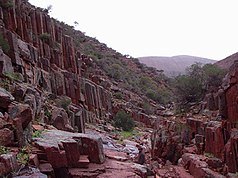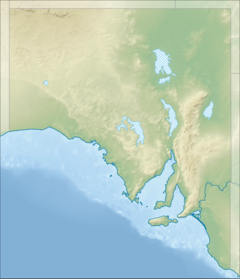Gawler Ranges National Park
| Gawler Ranges National Park | ||
|---|---|---|
| Kolay Mirica Falls | ||
|
|
||
| Location: | South Australia , Australia | |
| Specialty: | Kolay Mirica Falls | |
| Next city: | Wudinna | |
| Surface: | 1,663.03 km² | |
| Founding: | 2002 | |
The 1,660 km² Gawler Ranges National Park in South Australia is 510 km west of Adelaide . This park opened on January 15, 2002 and can be reached via the places on the edge of the park, Wudinna , Kimba and Minnipa . A common border with the 1320 square kilometer Pinkawillinie Conservation Park created an approximately 3,000 square kilometer park landscape.
geology
The park is home to volcanic mountains and hills of the southern Gawler range , which were formed about 1500 million years ago. As a result of volcanic activity, there were columns of basalt in various places . These stone formations, which are similar to an organ pipe, are known as "Organ Pipes". Other tourist attractions in the park are the angular rock formations of Peter's Pillars, the Paney Homestad, which dates back to the pioneering days, and the Pondanna Outstation. Several former river valleys run through the park, although today there are no year-round watercourses there. The Lake Gairdner north of the National Park is the fourth largest salt lake in Australia . The highest peaks are the Nukey Bluff with 457 meters, the Mount Fairview with 452 meters and the Paney Hill with 449 m. Sand dunes are in the extreme south.
climate
The summers in the park are mild to hot with average daily temperatures of 34 ° C, the winters are cool, sometimes cold. The daily maximum temperatures in winter are on average 19 ° C. The climate is dry, with the irregular rainfall mostly falling in winter. The average annual precipitation is 295 mm. The best travel times are winter and spring.
Flora and fauna
The national park lies between the Mallee areas of the Eyre Peninsula in the south and the desert regions in the north. As a result, it is home to a great diversity of species. The park is home to a total of at least 225 native plant species, 126 species of birds, 18 species of mammals, as well as 33 species of reptiles and 3 amphibians.
Notable species of birds from the Gawler Ranges include a. Thermometer chicken , emu , wedge-tailed eagle and Inca cockatoo . Among the mammals, the red giant kangaroo , the western gray giant kangaroo , the yellow-footed rock kangaroo , the mountain kangaroo , the southern hair-nosed wombat , the bilchbeutler , the sand-dune-narrow-footed bag-mouse and the jumping mice should be emphasized.
history
Little is known about the prehistory of the region. The two tribes of the region were the Wirangu and the Barngarla (Parnkalla). Since the national park has been settled by the Aborigines , the indigenous people of Australia , for a long time , there are eight significant cultural sites that are registered as worthy of protection.
The explorer Edward John Eyre was the first European to tour the Gawler Ranges in September 1839. He named the area after George Gawler , the second governor of South Australia. From 1864 livestock was kept here, which was made easier by a secure supply of drinking water from 1865.
Infrastructure
Camping is possible near Mount Ive Station . Four -wheel drive vehicles are required to enter the park, only the route from Paney Homestead to Old Paney is suitable for road vehicles. There are access to the park at Minnipa, Wudinna and Kimba. It is recommended to drive the Gawler Ranges from Minniap. Bush campsites are available to visitors as an overnight option.
Web links
- Official website (English)
- Pictures and a. also of the basalt columns (called organ pipe) (German)
Individual evidence
- ↑ Information on the Gawler Ranges , accessed June 10, 2011.
- ^ A b c d Department of Environment and Natural Resources: Gawler Ranges National Park Park information brochure. Government of South Australia. (Online PDF available at www.environment.sa.gov.au )
- ↑ a b Information brochure of the park administration, English, pdf ( Memento of the original from March 14, 2011 in the Internet Archive ) Info: The archive link was inserted automatically and has not yet been checked. Please check the original and archive link according to the instructions and then remove this notice.

